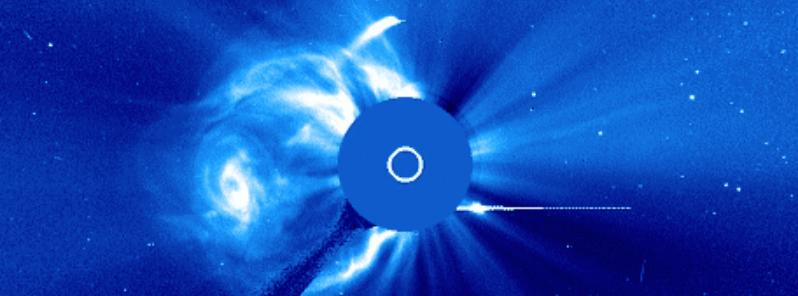Comet 96P/Machholz enters field view of LASCO coronagraphs

For the fifth time since SOHO launched in 1995, fascinating comet 96P/Machholz will be entering the field of view of the SOHO/LASCO coronagraphs. This year, however, it will also pass through the view of STEREO-A/SECCHI COR1 and COR-2 coronagraphs. For the first time, we will have simultaneous views of comet 96P from two different locations in space.
On October 25, 2017, comet 96P will enter the lower-right corner of C3 and skirt up and around the right-hand edge of the field of view, before leaving the field of view on October 30. Comet 96P was also visible in SOHO's field of view in 2012, 2007, 2002 and 1996, making it the most frequent cometary visitor to SOHO images.
Amateur astronomer Don Machholz discovered the comet in 1986, and it was soon revealed to be short-period, meaning its orbit around the Sun is less than 200 years. Comet 96P completes an orbit every 5.24 years and has its closest approach to the Sun at a rather toasty 0.12 AU (18 million km / 11 million miles). That's very close for a comet, and that alone makes it interesting. But comet 96P has much more to offer.
First, it has a family – a big family! Comet 96P is the parent of two separate families of comets (SOHO's "Marsden" and "Kracht" group comets), and the parent of the Daytime Arietid, Southern Delta Aquarids, and the Quadrantid meteor showers that Earth experiences every year. It might even be related to an asteroid. In addition, when comet 96P appeared in the SOHO's field of view in 2012, we discovered two tiny fragments some distance ahead of the main nucleus. This means that the comet is still actively evolving.
A scientific study published in 2008 found that comet 96P has "extremely anomalous molecular abundances" – which basically means it has a really weird composition when compared to all the other comets we know about.
In years past, comet 96P has produced some beautiful images from SOHO's imagers. Its passage in 2002 was perhaps the most stunning so far, with a bonus coronal mass ejection, or CME, erupting just a few hours after the comet passed the Sun.
Comet 96P/Machholz in 2002
This year, the comet will not only pass through field of view of the SOHO/LASCO coronagraphs, but also through that of the STEREO-A/SECCHI COR1 and COR-2 coronagraphs. The STEREO-A satellite – short for Solar and Terrestrial Relations Observatory Ahead – is currently quite some distance from Earth, the comet will pass directly through the field of view of the camera on October 26 – 28. For the first time, we will have simultaneous views of comet 96P from two different locations in space.
Over the next two weeks, SOHO will update this page with images and movies from the comet's passage. Because STEREO-A is so far from Earth, downlinking data takes a while. However, SOHO returns data in, near real-time so you can watch events unfold live on the SOHO website.
Featured image: Comet 96P/Machholz in 2002. Credit: ESA/NASA SOHO/LASCO C3

Commenting rules and guidelines
We value the thoughts and opinions of our readers and welcome healthy discussions on our website. In order to maintain a respectful and positive community, we ask that all commenters follow these rules.